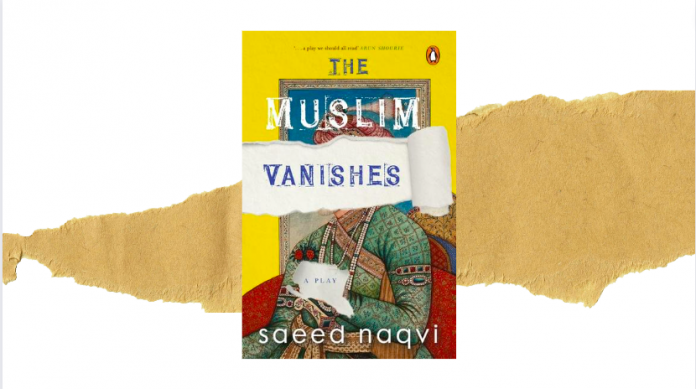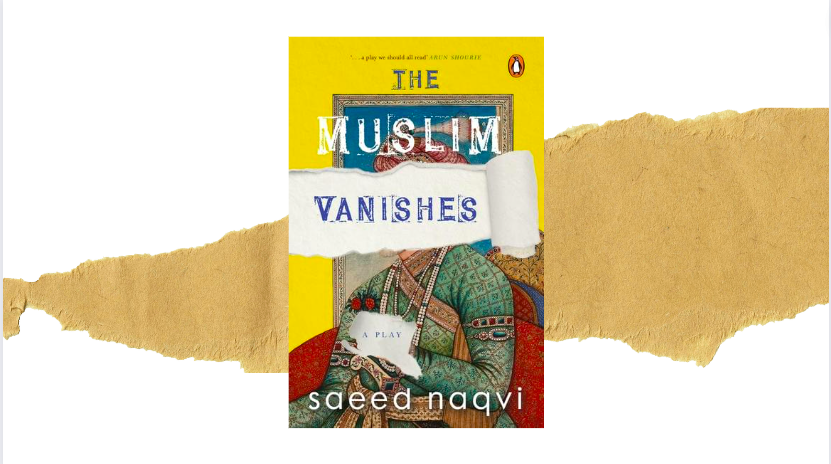The Muslim Vanishes: A Play
by Saeed Naqvi
Publisher: Penguin Vintage Books
In “The Muslim Vanishes”, renowned journalist Saeed Naqvi presents an intriguing premise, “What if one day, all the 200 Muslims of India were to vanish?”
And he answers this dystopian question in a play. Unlike the ‘drama of ideas’ of George Bernard Shaw, this play within a book is intended to play out in the reader’s mind. Mr. Naqvi shows generosity, insight, and balance while presenting the proposition to us. This is an intellectual inquiry by the writer and is showcased, in his own words, “…by a format of dialogue, point-counterpoint, peel by peel like an onion, all set in a fast-paced drama to keep the attention riveted…”
The action takes place immediately after all the Muslims vanish and the story breaks in a news studio with the primetime anchors Anand and Brajesh receiving the news. Infusing humour throughout the drama, we note not only have all the Muslims vanished, but the Qutub Minar has also disappeared. For many, this is a dream come true, a Muslim-mukht Bharat. The property and businesses of the minority are up for grabs by the end of Scene I of Act I.
Anita, the socialist wife of Brajesh, sees the disappearance as “God’s gift to socialism” and contends that ownerless property can now be equally distributed among society. Having harbored dreams of being a farmer, she rushes to claim a buffalo shed and is dismayed to find it has already been allocated by the Dalit Samaj Committee to its member. Brajesh, an upper caste member is quick to realise, a Muslim-mukht Bharat means communalism has now been replaced by casteism and frames Savarnas vs. Avarnas or Upper castes vs. Lower castes.
Fearing a revolution afoot, Brajesh and his father, the politician Shuklaji now lament the loss of their Muslim brothers. They surmise the vacuum of the Muslim vote will surely lead to consolidation of the already considerable Dalit vote bank. They decide to forestall the elections and if required, revolt against the Constitution. The voters call out double-dealing leaders who had labelled Muslims as a threat and now claim the vanished population is essential to the functioning of Indian democracy.
The question of why Muslims disappeared is never answered. It is certainly alluded to. The real question that is posed is, “Will they return?” The Qutub Minar does come back. Giving the vanished agency, Urdu and Persian words, Mughal miniatures, spirits, and works of Muslim artists disappear and reappear, impacting language, culture, cuisine, and daily lives.
A special court with a jury of dead secular spirits comprising with likes of Salbeg, Sant Kabir, Tulsidas, etc is summoned to decide on the issue of Muslim disappearance. Through the trial, the Hindu and Muslim representative put their respective cases forward. History is reviewed under each lens and each period – Before Islam, Mughal era, British colonial rule, Independence, Partition, After 1947 till date, providing perspective and explanation for the state of affairs today.
The author does not spare his own profession in its role of aggrandising conflict between communities and points toward the danger of market-driven media. Inherent, systemic inequality emerges as the root cause of evils for our nation at trial.
By the end, solutions are suggested and we do see a glimmer of hope for our nation and all her people. The knowledge and expertise of the author in history, current events, and arts come through these passages. If there is a negative, the influence of Islam in the North is highlighted and while the South is mentioned, it is negligible.
This could have been a heavy, dense, impenetrable work on the subject alone but Saeed Naqvi’s choice of form, use of language, and lightness in execution make this an immensely readable and enjoyable book.
As mentioned before, this is a drama of ideas and not characters, the characters are stereotypical and serve as props. The dialogue propels the story/drama forward and is not necessarily quotable. That is not to say the work has no literary merit, the author is more than capable and shows flair, especially in the conclusion, where arguments, perspectives, and solutions are all condensed in amusing, lyrical, and memorable form.
A charming and witty book with an elegant and emphatic cover design by Antra K with the vivid profile portrait of the Mughal vandalised for effect.






RELATED ARTICLESMORE FROM AUTHOR
Swallowing the Sun
Death of a Gentleman
Sinema: : The Bollywood Bungle of Andy Duggal